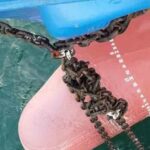Real Life Accident: Improper Bridge Procedures And ECDIS Use Causes Grounding of Ship
A self-unloading bulk carrier sailed in the morning after loading a cargo of aggregates. The pilot disembarked soon after unberthing, and the vessel proceeded at Full Ahead (about 12 knots) with the Master, 3/O and a helmsman manning the bridge. Visibility was good with a moderate breeze. Besides the two radars, the bridge team was using an ECDIS, on which, a safety contour of 10 metres (inappropriate, considering a sailing draught of 10.63 metres), a cross-track deviation limit of 0.2 mile and an anti-grounding warning zone that covered a narrow arc ahead to a range of about ten minutes’ steaming had been set.
About an hour after departure, the vessel entered a narrow strait, where the Master instructed the helmsman to engage the autopilot on a heading of 290º and handed over the con to the 3/O. He then proceeded to the communications desk on the after port side of the bridge, increased the volume of a portable music system and busied himself with sending routine departure messages. A few minutes later, the vessel was approaching a planned waypoint requiring an alteration of 24º to starboard to 314º. At this time, the 3/O visually sighted an inbound sailing vessel about 3 NM on the starboard bow. After coming on to the new course on the autopilot, he decided to pass the sailing vessel to port and adjusted the course to 321º. Simultaneously, he observed another small vessel about a mile away, right ahead and coming head on, and altered more to starboard to 324º.
The ECDIS anti-grounding warning zone alarm then activated on the display, but no audible alarm sounded, a deficiency not known at the time. As a result, the 3/O, who was monitoring the situation from the forward console, did not realize that the vessel was heading towards shoal ground. He also sounded two long blasts on the ship’s whistle to alert the nearest vessel, which soon passed clear to port.
Thereafter, the 3/O focussed his attention on the sailing vessel ahead, which was now about a mile away. Two minutes later, the vessel ran onto a charted shoal at full speed. The severe vibrations lasted several seconds. The Master ran to the ECDIS display and, recognizing that his vessel had run aground, instructed the helmsman to switch to manual steering and ordered the wheel to hard-a-port. The sailing vessel also altered course to port and the vessels narrowly avoided colliding. After he steadied the vessel on a heading to return her to the planned track, the Master discovered that there was water ingress in No 3(P) ballast deep tank. Further checks revealed no other damage, and a preliminary report was sent to the office.

Proceeding at reduced speed, tank soundings confirmed that the ship’s pumps were able to cope with water ingress. Nevertheless, the Master ordered the breached compartment to be opened at sea and for a party consisting of the C/O, C/E and a seaman to internally inspect the damage. After they identified a 3-metre longitudinal fracture in the hull bottom plating, the inspection team safely vacated the tank and re-secured its access. With company’s and class approval, the vessel continued on its short passage towards the discharge port, where, after unloading, she entered drydock to effect permanent repairs
Findings of investigation
- The vessel was fitted with two ECDIS units that were used as the primary means of navigation, thus removing the need for paper charts to be carried. All bridge officers, including the Master, had completed a generic ECDIS training course in their home country, but no training or familiarisation on the type of ECDIS fitted on board had been provided by the ship’s management company;
- Before reaching the waypoint, the 3/O wrongly assumed that risk of collision existed with the sailing vessel on the next planned heading and prematurely initiated a turn to starboard and then continued to alter course to starboard, illogically intending to pass between the sailing vessel and the steep-to shore;
- After initiating the course alteration, the 3/O did not monitor the vessel’s position and projected track on the ECDIS display, for over 15 minutes, and failed to notice that the visual grounding warning alarm had been activated;
- Both the present and past crews were unaware that the ECDIS antigrounding audible alarm had been disconnected in the past for unknown reasons;
- The vessel’s ECDIS display was located some distance abaft the bridge front and orientated so that the OOW had to face to starboard to look at the screen. Had the ECDIS display been located on the forward console, the OOW would have been more likely to routinely consult it when monitoring the navigational situation and also been alerted by the visual grounding warning alarm;
- A safety contour setting of 10 metres was inappropriate for the voyage as the sailing draft of 10.63 metres meant that the vessel would have grounded at a charted depth of 10.13 metres, before crossing the safety contour;
- Despite having attended approved ECDIS training courses, the bridge watchkeepers lacked an understanding of the ECDIS equipment’s safety features;
- The 3/O remained confident in functioning as the sole navigator in restricted waters, but soon after the multiple small alterations of course, he became sufficiently concerned about the intentions of the nearest vessel ahead to sound two long blasts on the ship’s whistle. The Master failed to react to this inappropriate signal and did not leave the communications console at the rear of the bridge to assess the situation or challenge the 3/O’s actions;
- Following the grounding, the bridge team failed to follow the company’s emergency checklist or maintain a proper record of follow-up actions taken, as a result of which, some important responses were missed;
- No risk assessment or consideration of potential consequences was undertaken prior to opening up and ordering entry into the breached ballast tank with the ship at sea and proceeding at near full speed.
Lessons learnt
- ECDIS provides the bridge team with an efficient and effective means of navigation. However, its ability to continuously provide the vessel’s current position and projected track, and to warn of approaching dangers, can lead to over-reliance and complacency.
- It is imperative that navigators be given equipment-specific training and onboard instructions and guidance to monitor the vessel’s position and projected track at regular intervals and to fully understand the equipment’s safety features in order to make best use of them;
- The area where the accident occurred required careful navigation in view of the vessel’s size, speed, restricted sea room and the likelihood of her encountering other traffic;
- The Master placed undue trust in the 3/O’s abilities, offering him no support despite the navigational demands of the passage;
- The Master should have delayed sending the routine departure messages until the vessel was clear of the narrow passage;
- Loud music can impair the keeping of a proper lookout as required by Rule 5 of the Colregs. Had the ECDIS audible alarm been functioning, it might still not have been heard by the 3/O due to the background noise pollution provided by the loud music;
- As it was established that the ballast pump was capable of stemming the inflow of water, the opening of a breached compartment and entry by personnel constituted an unacceptable and unnecessary risk.
Corrective/preventative actions
- The ship operator implemented the following corrective actions in the drydock:
i. Repositioned the main ECDIS unit adjacent to the starboard radar, enabling its viewing while facing forward;
ii. Reconnected the ECDIS unit to the bridge alarm monitoring unit to provide a functioning audible alarm;
iii. Arranged for the vessel’s bridge officers, and company’s Designated Person (DPA) and marine / nautical superintendent to attend an equipment-specific training course on the ECDIS type fitted on board; - Arranged for the fleet’s bridge officers to attend a bridge resource management course;
- Arranged for the marine / nautical superintendent to provide on board ECDIS training to the fleet’s other vessels fitted with ECDIS or electronic charts.
Recommendations
The ship operator was advised to issue written instructions and guidance to the fleet and carry out regular verification visits to its vessels to ensure that ship’s staff:
- Have a clear understanding of how ECDIS should be used;
- Understand the vessel’s emergency procedures,
- Understand the need to properly evaluate routine operations after an accident to ensure that any new risks are identified and mitigated as appropriate.
Reference & Image Credits: nautinst
Do you have info to share with us ? Suggest a correction
- Real Life Incident: Vessel Collision in Good Visibility
- Real Life Incident: Severe Injury To Deck Crew While Leaving Berth
- Real Life Incident: Departure Damage in Very Restricted Waterway
- Real Life Incident: Low Situational Awareness Has High Impact Consequence
- Real Life Incident: Fouled Anchor in a Designated Anchorage
- Real Life Incident: Fire On Barge Carrying Scrap Metal Causes $7 Million Worth Of Damage
Latest Case studies Articles You Would Like:
Subscribe To Our Newsletters
By subscribing, you agree to our Privacy Policy and may receive occasional deal communications; you can unsubscribe anytime.
Web Stories






















I might have missed something here, but my question is, what disciplinary steps were taken? This story reflects, a) an over-reliance on technology and, b) poor general discipline, combined with c) poor leadership with regards to Standing Orders and Procedures. What would have been done had the ECDIS warning system not been on board at all?
Read Recent article regarding Grounding due to improper use of ECDIS procedures . Shared with navigators on board and discussed . Very helpful articles .
We are glad you found the information useful! Thank you!
Has anyone really ask these questions;
1. The equipment that is fitted on board ships are getting more and more sophisticated and advanced. All of which are done to improve safety, whether deck dept or engine dept. But why has maritime accidents increased over the years?
2. Ships have more and more automated equipment now. These are fitted to ensure that a large vessel can be operated by a lesser complement of crew compared to a similar sized vessel twenty years ago.
These automated equipment also ensure that the crew have a more comfortable and easier working environment. But why have qualified sailors dwindled over the years?
The Master is overburdened by his function as communication officer, doing the job of a sparks, and also by all the shore imposed bureaucracy making him act as a secretary more than as a master..
The situation was too complicated for a young third officer to deal with, in spite of the thousands of gadgets and other stuff we did not have, nor needed, 50 years ago.
I agree with Capt. Jacobus P. De Bruyn. How to postpone routine reports and focus on navigation in Marmara sea when I had 4 hours between ports?
Shipping industry must decide who the captains are. Masters or clerks.